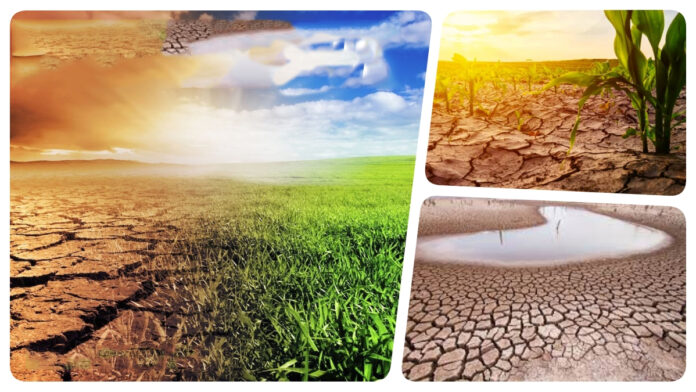Climate change has been important factor in environmental as well as economic aspects of Pakistan. Changing weather patterns have caused droughts in fertile lands, and excessive rains in dry and arid regions. This, in turn, has caused issues for the management of livestock in the country. The depletion of existing pastures is leading towards rising costs of fodder.
According to latest research, the effects of climate change are not just limited to crops and agricultural production. Climate change will have far-reaching consequences for dairy, meat and wool production, mainly arising from its impact on grassland and rangeland productivity. Heat distress suffered by animals will reduce the rate of animal feed intake and result in poor growth performance. Lack of water and increased frequency of drought in certain countries will lead to a loss of resources. Consequently, as exemplified by many African countries, existing food insecurity and conflict over scarce resources will be exacerbated. Therefore, due importance needs to be given towards livestock management in the light of climate change.
In pastoral and agro pastoral systems, livestock is a key asset for poor people, fulfilling multiple economic, social and risk management functions. The impact of climate change is expected to heighten the vulnerability of livestock systems and reinforce existing factors that are affecting livestock production systems, such as rapid population and economic growth, rising demand for food (including livestock) and products, conflict over scarce resources (land tenure, water, biofuels, etc). For rural communities, losing livestock assets could trigger a collapse into chronic poverty and have a lasting effect on livelihoods. The direct effects of climate change will include, for example, higher temperatures and changing rainfall patterns, which could translate into the increased spread of existing vector-borne diseases and macroparasites, accompanied by the emergence and circulation of new diseases.
Some of the key points that contribute towards the issues are detailed below.
- Heat Stress
Rising temperatures are a big threat for livestock. Animal suffering from heat stress eat less, grow slower and produce less milk or meat and had higher rate of diseases. Respiration rates and body temperature are both good ways to assess how well animals are managing their heat production and losses in warm weather. Physical appearance and body temperature also gives a direct measure of an individual animal’s heat stress level. Temperature and humidity levels determine when the animal may start feeling heat stressed. Shade and proper ventilation are critical to lowering the incidence of heat stress.
- Reduced Feed Quality and Quantity:
Drought and extreme weather conditions can affect feed crops. The quality, composition, and palatability of feed ingredients significantly influence feed intake. Animals have preferences for certain feed ingredients based on taste, odor, texture, and digestibility. This can lead to malnutrition in livestock and lower-productivity.
- Water Supply
Changes in rainfall and increased evaporation due to heat can lead to decrease the water supply. Even this reduces the availability of drinking water for livestock and impacts and the growth of feed crops. Limitation of water intake reduces animal performance quicker and more dramatically than any other nutrient deficiency. Animals that do not drink enough water may suffer stress or dehydration. Every animal is in dire need of clean and fresh water owing to the overly polluted water that they normally have access to, such as drains, puddles, polluted ponds, lakes and streams or rivers. Polluted water can push animal life to tragic ends, for instance, chemical contaminants from industrial pollution, an excess of nutrients like nitrogen and phosphorous, oil spills and dumping of solid trash such as plastic can lead to death of animals drinking water from the polluted sources; high levels of mercury in water can induce hormonal imbalances in animals consuming it; and additionally, polluted water from irrigation and air pollutants that form a part of toxic rains can cause mortal
and irreversible injuries in animals.
In order to mitigate the risks caused by above factors, there is an urgent need to develop some strategies. Some of them are listed below:
- Investing in livestock cross-breeding that are more tolerant of heat and drought conditions.
- Improving shelter and ventilation for animals.
- Adjusting feeding practices to ensure proper nutrition during heat stress period.
By taking these actions, we can help to lessen the impact of climate change on livestock production and ensure a more sustainable future for this important-sector.
Recommendations for future progress via technology
Potential opportunities are available for investors, government departments, researchers, economists and policymakers to positively influence the future development of Pakistan’s livestock sector and thereby contribute to poverty alleviation, food security and economic growth. There follows a list of possible actions:
- Government authorities to introduce relevant curricula and conduct hands-on training to help students learn advanced technologies to meet practical goals
- Community-based advanced systems training and workshops to train farmers and agricultural consultants in advanced technologies ● Government livestock departments to take initiatives to develop individualized cattle-based traceability, monitoring, and evaluation ● Make PLF consultants and service providers more aware of the conditions prevailing in Pakistan such that they understand and can respond to farmer’s needs
- Extend this consultant/farmer relationship to provision of practical solutions together with physical support for appropriate training, smooth deployment, timely resolution of issues and avoidance of overly-complex and hence impractical technology
- Develop systems to connect small farmers with each other to form viable conglomerates that can afford to invest in advanced technologies ● Expand these systems to connect small, mid and corporate farms and create links to regional and national agencies in order to establish national livestock traceability and surveillance
- Establishing a national or regional dairy herd association(s) and promoting an open information-sharing culture within the developed farmer networks may support researchers, institutions, and agencies.























